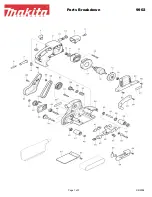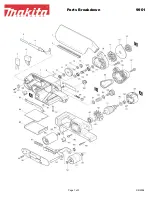
-18-
G0596-G0599 Industrial Bench Grinders
Review the troubleshooting and procedures in this section to fix your machine if a problem develops. If you
need replacement parts or you are unsure of your repair skills, then feel free to call our Technical Support
at (570) 546-9663.
SECTION 6: SERVICE
Troubleshooting
Motor & Electrical
Symptom
Possible Cause
Possible Solution
Motor will not start. 1. Low voltage.
2. Open circuit in motor or loose connections.
1. Check power line for proper voltage.
2. Inspect all lead connections on motor for loose or open
connections.
Motor will not start;
fuses or circuit
breakers blow.
1. Short circuit in line cord or plug.
2. Short circuit in motor or loose connections.
3. Incorrect fuses or circuit breakers in power line.
1. Inspect cord or plug for damaged insulation and shorted
wires.
2. Inspect all connections on motor for loose or shorted termi-
nals or worn insulation.
3. Install correct fuses or circuit breakers.
Motor overheats.
1. Motor overloaded.
1. Reduce load on motor.
Motor stalls (result-
ing in blown fuses
or tripped circuit).
1. Short circuit in motor or loose connections.
2. Low voltage.
3. Incorrect fuses or circuit breakers in power line.
4. Motor overloaded.
1. Inspect connections on motor for loose or shorted terminals
or worn insulation.
2 Correct the low voltage conditions.
3. Install correct fuses or circuit breakers.
4. Reduce load on motor.
Machine
slows
when operating.
1. Operator is using too much pressure.
1. Use less pressure when grinding.
Wavy
condi-
tion on surface of
workpiece.
1. Machine vibrating.
2. Workpiece not being held firmly.
3. Wheel face uneven.
4. Wheel is too hard.
1. Make sure machine is securely mounted on a solid sur-
face.
2. Use a holding device to firmly retain the workpiece.
3. Dress the grinding wheel.
4. Use softer wheel, or reduce the feed rate.
Lines on surface of
workpiece.
1. Impurity on wheel surface.
2. Workpiece not being held tightly.
1. Dress the grinding wheel.
2. Use a holding device to firmly retain the workpiece.
Burning
spots
or cracks in the
workpiece.
1. Improper type of grinding wheel.
2. Improper feed rate.
3. Coolant required.
1. Try a wheel which is softer style or a coarser grit.
2. Slow down the rate of movement of the workpiece into
wheel.
3. Add optional coolant system or introduce coolant by hand.
Wheel dulls quickly,
grit falls off.
1. Depth of cut too great.
2. Wheel is too soft.
3. Wheel diameter too small.
4. Bad wheel dress.
5. Defective wheel bonding.
1. Slow down the rate of movement of the workpiece into
wheel.
2. Wheel too soft for the material being ground, select harder
bond.
3. Replace the wheel.
4. Dress the wheel.
5. Consult manufacturer of grinding wheel.
Summary of Contents for G0596
Page 2: ......
Page 14: ...12 G0596 G0599 Industrial Bench Grinders Hardware Recognition Chart...
Page 21: ...G0596 G0599 Industrial Bench Grinders 19 110V Wiring Diagram G0596 Single Phase...
Page 22: ...20 G0596 G0599 Industrial Bench Grinders 220V Wiring Diagram G0597 G0598 Single Phase...
Page 23: ...G0596 G0599 Industrial Bench Grinders 21 220V Wiring Diagram G0599 3 Phase...
Page 24: ...22 G0596 G0599 Industrial Bench Grinders Parts Breakdown Main...
Page 29: ......
Page 30: ......
Page 31: ......
Page 32: ......













































